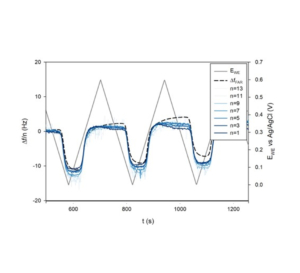November 27th 2020: AWSensors is pleased to invite you to take a look to the its new electrochemical QCM (EQCM) Application Note on battery electrodes entitled “In-Situ Study of Composite LiFePO4 Electrodes for Battery Applications“.
Summary of the Note
Use of AWSensors X1 instrument in combination with a compatible potentiostat to perform an electrochemical study of various processes accompanying Li-ion intercalation into battery and supercapacitor electrodes onto the gold surface of 5 MHz QCM sensors.

Introduction
LiFePO4 (LFP) electrode is widely used in Lithium Ion Batteries (LIB) as a practical cathode. It is considered as one of the safest, toughest and most cost-effective cathodes for lithium batteries available today. It possesses a stable electrochemical response, expressed by sharp intercalation and deintercalation peaks during voltammetric cycling. The relatively low working potentials of the LFP provide an electrochemically stable potential window in which only Li insertion/extraction processes take place without the contribution of parasitic processes associated with high operation potentials.
Continue reading by downloading the full Application Note (below) …
Download Full Application Note
You can download the full EQCM Application Note in pdf file from this link or download it from our Applications Web Page where you can find this and the rest of our Application and Technology Notes.
Other References
.
EQCM: What is it?
EQCM stands for Electrochemical Quartz Crystal Microbalance and it is the combination of Quartz Crystal Microbalance measurements with simultaneous measurements of electrochemical events using a potensiostat/galvanostat.
EQCM: What it is used for?
EQCM measurements are generally performed to study battery electrodes, super-capacitors, corrosion, etc.




